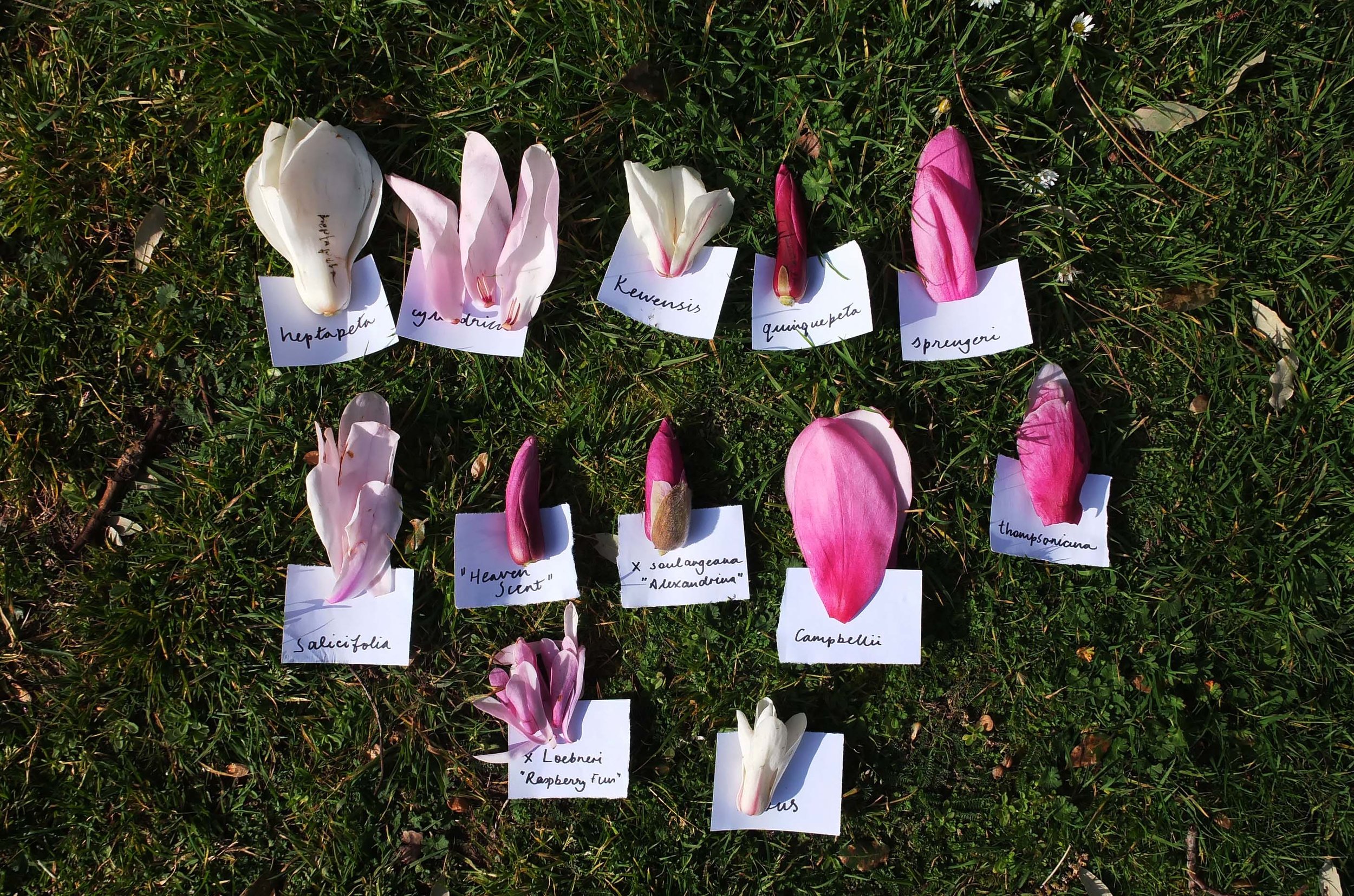A blog in collaboration with ethnobotanist Harriet Gendall
Spring brings plenty of beautiful blossoms to signal winter is over (almost). Cherry, blackthorn and magnolia always say to us ‘spring is here and summer is coming’. In this blog, we took the opportunity to test out a commonly foraged plant, Magnolia (Magnolia spp.) whose petals are used as for spicing things up. There are many varieties and we explored which varieties were best for nibbling on, and you will find some tasting notes towards the end of the blog.
Edible uses
The fresh flower petals have a pungent ginger-cardamomy taste, and make ideal ‘pops’ of taste when added to a salad. Not too much though, as they can be quite strong. Before tasting, please check out safety thoughts at the bottom of this blog.*
If you’d like to benefit from magnolia all year round, they can be dried for sprinkling onto foods, or using in place of ginger or cardamom things, but they aren’t quite as pungent., so not ideal for long cooking. The petals can also be infused into a light vinegar, such as white wine vinegar, to make a salad dressing.
A little natural history & safety
The magnolia is a really old type of tree, evolving before bees did. Its petals are an unusually thick, needing to be tough for the big beetle pollinators that were around at the time. They are not native to the UK, originating in SE ASia and N America, but are commonly planted as a showy garden, park and street plant, so there are plenty of opportunities to forage your own set of blooms.
After checking out www.pfaf.org, a useful and reliable resource on the edible and medicinal uses of plants, we found that many have edible and medicinal applications. In fact some species are used for coughs and congestion in Traditional Chinese Medicine (TCM) (Hou Po Hua, Xin Yi) (辛夷). The fuzzy flower buds of M. biondii are decocted for congestion and the bark of M. acuminata is used in decoctions for fever.
They are eaten in china and there is a beautiful video at the end of the page to watch about making magnolia delicacies.
(C) Harriet Gendall
The tasting project
We collected and tasted many varieties and species of magnolia, finding a surprising wide variation in flavour. We then mapped them on to a grid based on their profile. Every person has different tastes, and every tree may taste different depending on its growth, age, time of harvesting and environment, so the table is just a general guide. Other limitations are that not all magnolias flower at the same time, so age of flower at harvest may affect taste.
All the magnolia flowers have a general ginger-cardamom flavour, so the table below refers to the major taste profiles for each variety.
The centre of the flower (Disc that holds stigma/stamens) is even more strongly flavoured.
Our major take home message/rule of thumb was this:
Stronger flavours on the spectrum are associated with deeper pinkness, but too pink and the taste becomes bitter and overwhelming. The white and light varieties of flower were not always strongly flavoursome. Therefore, as a general rule, for using fresh, the best flowers to forage are the flowers that have a white/pink bi-colour or are pink outside/white inside followed closely by the flowers that are a single tone mid-light pink throughout. The darker pink ones are more bitter fresh but may be better for drying as the flowerflavour degrades on storage.
Please also check the safe species list at base of page.
Dark pink = bitter, gingery-chilli
Pink/White = the gingery, cardamommy flavours
White = more lemony, subtle, sometimes floral
Drying may change the flavour profile too, but in the quick check we made after drying, the stronger flavors were fairly stable. The lighter citrusy-flavoured petals are probably best used fresh; for example, the M. loebneri ‘raspberry fun’ and the M. kobus, seemed perfect for adding small fresh pieces to mixes of other edible flowers on cakes. However, after harvesting they turn brown quite quickly, which means that they don’t look as attractive as the pink varieties.
Table key: L= Low, M=Medium, H=High (levels of bitterness).
*SAFETY
List of known edible species
The following are KNOWN edible species, taken from Robin Harford’s Eatweeds blog Link Here. Please do not eat outside this range unless you find a good reference for doing so.
Magnolia coco
Magnolia grandiflora
Magnolia denudata
Magnolia hypoleuca
Magnolia kobus
Magnolia mexicana
Magnolia pterocarpa
Magnolia soulangeana
We tested out further species in the table at our own risk as there is no known toxicity to magnolia (unless someone had an allergy) But please take care, and be moderate in all you do! Don’t go juicing a ton of them or eating them three meals a day. Seasonal foraging is all about grazing and adding lots of different things here and there.
*There is a general guide for foraging safely in the ‘website use guidelines’ at the bottom of the page. Please read it. Always remember to test your sensitivity to plants before use. Always be 100% certain you have correctly identified the species. Learn to forage safely and sustainably.
(C) Harriet Gendall





